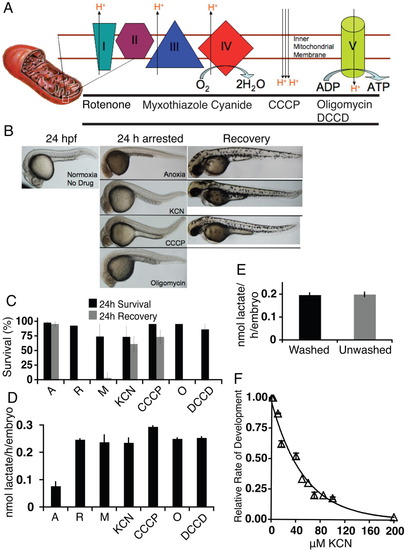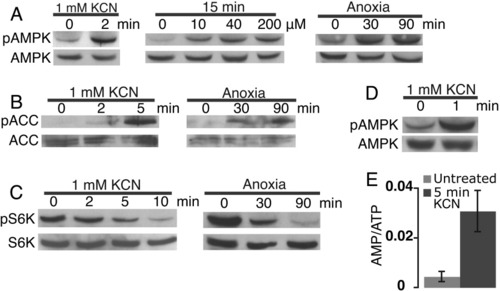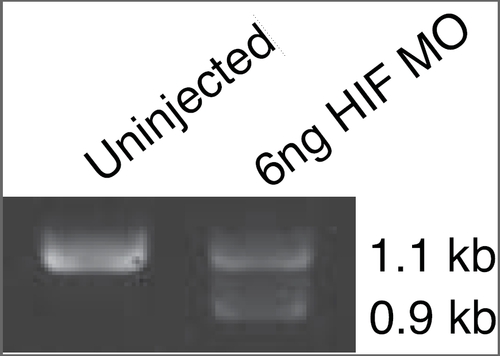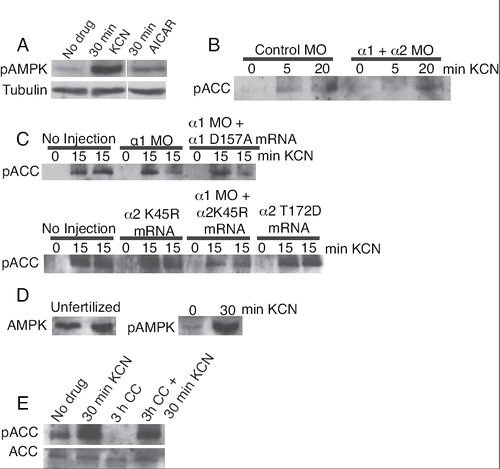- Title
-
The zebrafish embryo as a dynamic model of anoxia tolerance
- Authors
- Mendelsohn, B.A., Kassebaum, B.L., and Gitlin, J.D.
- Source
- Full text @ Dev. Dyn.
|
Anoxic arrest is mimicked by chemical inhibition of oxidative phosphorylation. A: Schematic of the electron transport chain indicating the sites of action of mitochondrial inhibitors. B: Images comparing embryos incubated in anoxia or various inhibitors for 24 hr, and then the same embryos after 24-48 hr of recovery after a return to normoxia or washing of the chemical inhibitor. C: The percent survival after 24 hr of anoxia or treatment with chemical inhibitors beginning at 24 hours post fertilization (hpf) and the percent recovery after an additional 24 hr was measured. A, anoxia; R, rotenone; M, myxothiazole; O, oligomycin. D: Rate of lactate accumulation in 24 hpf embryos after 8 hr in different mitochondrial inhibitors or anoxia. E: Four hours postfertilization embryos were incubated for 1 hr in 10 μM oligomycin, were washed or left in the drug for 17 additional hr, and the rate of lactate accumulation was determined. F: Embryos at 5 hpf placed into varying doses of KCN were incubated for 24 hr after which the relative rate of growth was determined as described in the Experimental Procedures section. The best-fit line describes an exponential decline (R2 = 0.99). All experiments were performed at 24°C. All error bars are ±SD. |
|
The AMP-activated protein kinase (AMPK) pathway is activated by the inhibition of oxidative phosphorylation in zebrafish embryos. A: Immunoblot analysis of AMPK phosphorylation before and after 2 min in KCN, with increasing KCN doses, or with increasing time in anoxia. B: Phosphorylation of Acetyl-CoA Carboxylase (ACC) with time in KCN or anoxia. C: Phosphorylation of p70-S6 Kinase (S6K) in KCN or anoxia. D: Seventy-two hour postfertilization (hpf) embryos were incubated in KCN and the timing of AMPK phosphorylation was assessed. E: Change in the AMP/ATP ratio after a 5 min inhibition of oxidative phosphorylation as described in the Experimental Procedures section. Error bars are ±SD. All experiments used 24 hpf embryos. EXPRESSION / LABELING:
|
|
Injection of an antisense morpholino oligonucleotide (MO) directed against a splice junction in the zebrafish hif1 and RT-PCR analysis of the hif1 transcript to detect aberrant splicing caused by the MO. |
|
Morpholino, dominant negative, and pharmacologic antagonism of AMPK activity have not sufficiently reduced its activity to determine the necessity of AMPK for anoxic adaptation. A: Activation of AMPK as indicated by increased phosphorylation was not induced by incubation in 10 mM 5-aminoimidazole-4-carboxamide-1-β-D-ribofuranoside (AICAR), and no effect on development was observed. B: Co-injection of 12 ng of antisense morpholino (MO) directed against both 1 and 2 isoforms of zebrafish AMPK did not abrogate the phosphorylation of ACC in KCN and did not produce any change in anoxic viability. C: Injection of MO to AMPK1 or co-injection with mRNA expressing the D157A dominant negative AMPK did not prevent ACC phosphorylation in KCN, nor did injection of the K45R dominant negative mutant with or without co-injection of the 1 MO. No increased phosphorylation of ACC was detected with the constitutively active T172D mutant. Morpholino plus K45R may have reduced ACC phosphorylation, but this treatment was extremely toxic in normoxia, and nevertheless none of these treatments prevented anoxic survival. D: AMPK protein was present in unfertilized eggs, and incubation of unfertilized eggs in KCN caused a dramatic increase in the phosphorylated form of AMPK, indicating a maternal contribution of AMPK protein that can be activated. E: If an immunoblot is exposed for longer, some basal phosphorylation of ACC can be detected. Incubation of 6 hpf embryos for 3 h in 40 μM of the AMPK inhibitor Compound C (CC) reduced this basal ACC phosphorylation but did not prevent ACC phosphorylation in KCN and did not reduce the duration of anoxic viability. Higher doses of CC were lethal in normoxia and often precipitated out of solution. All treatments with KCN were at 1 mM. |




